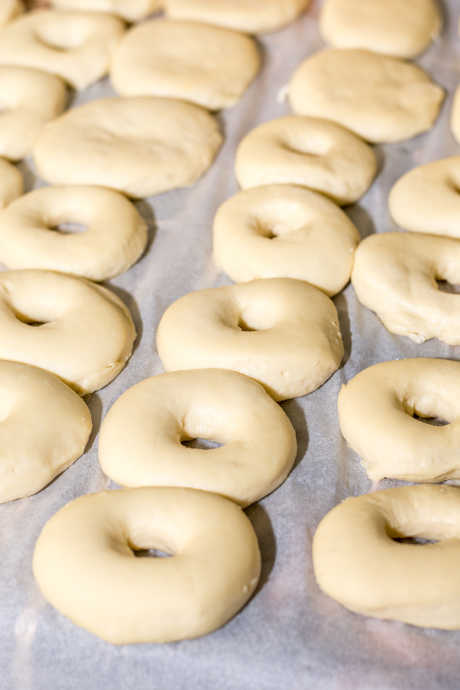Homemade Bagels: How to Make a New York Bagel Anywhere
Posted by Julie on Feb 7th 2019
Bagels were once a New York specialty, but nowadays you can find bagels coast to coast in bakeries, bagel shops, and even the grocery store. The basics of making bagels are similar no matter what recipe you use, and every bagel recipe calls for briefly boiling the rings of dough before baking them into bagels. However, not all bagels are equally delicious.
We researched tips and tricks to make your homemade bagels the best they can be. We found some great advice to share, along with three recipes that each take a different approach to bagel-making. Let us know which one you try!
Homemade Bagels: Ingredients
You’ll be pleased to learn you don’t need any special ingredients, let alone New York water, to make an authentic bagel. In fact, even the tips that came straight from a bagel-making course at the Institute for Culinary Education (ICE) say nothing about the water, except that it ought to be cold.
Likewise, the flour doesn’t need to be specially-sourced either. You will want to use bread flour, with its high levels of gluten. As ICE explains, with everything you’re going to put your dough through in the bagel-making process, it’s going to need more gluten than all-purpose flour offers.

The one ingredient you may not have on hand is malt syrup. Depending on the recipe you choose, it may be an ingredient in the dough, the boiling water bath, both of these, or neither of these. It does give bagels a characteristic taste that you may miss if you choose to use a different sweetener, like brown sugar or honey.
Homemade Bagels: Kneading and Proofing
When kneading your bagel dough, a food processor or stand mixer is your best bet if you’re not a seasoned bread baker. ICE recommends six minutes of mixing with a dough hook on low speeds. However, Serious Eats cautions bakers that more mixing may be required to properly develop the gluten. When in doubt, keep mixing.

Proofing is what makes New York bagels stand out. As we discovered in our post about homemade soft pretzels, if you can manage to let your dough sit in the refrigerator for several hours, it makes a noticeable difference in the taste of your finished product. But you can also let your dough rise at room temperature, and ICE reassures bakers your kitchen temperature doesn't matter. Don’t be in too much of a hurry though; Serious Eats notes that if you don’t let the dough rise enough, your bagels will turn out misshapen.
Homemade Bagels: Shaping and Boiling
There are a couple approaches to shaping bagels. Novices should start by rolling the dough into balls. Then poke a hole in the middle. Stretch the dough out on all sides until it forms a ring. Experts can give the ICE method a try. Roll each portion of dough into a rope, and then connect the ends. Either way, don’t worry if the loop looks too thin; it will puff up again when you boil and bake the bagels.
This video from Susan’s Cooking School is a great way to see how your bagel dough and bagels will look at various stages in the bagel-making process.
Be sure to allow the water to return to boiling between batches of bagels. Take a tip from Susan, and use a cooling rack set over a baking sheet for draining your bagels after boiling. We also like how she uses tongs to remove the bagels and return them to the cooling rack after they come out of the oven.
Basic Homemade Bagel Recipe: King Arthur Flour
This recipe got rave reviews from commenters, and King Arthur Flour is great about responding to comments. They even have a baking hotline. Similar to the basic option for homemade soft pretzels, this recipe calls for a short rise time. You can have bagels the same day you start. King Arthur Flour recommends using a wide pan like a sauté pan for the boiling water bath. They also offer helpful instructions for flavor variations, especially cinnamon raisin, with an ingenious way to get the cinnamon sugar swirls.
Intermediate Homemade Bagel Recipe: Susan’s Cooking School
This recipe goes along with the video from Susan’s Cooking School. It begins with a sponge, which calls for combining a portion of the flour plus all the yeast and water. Allow the sponge to ferment and rise before adding the rest of the flour and kneading with a stand mixer and dough hook. This method helps develop more flavor and creates a lighter texture. Use it to elevate any bread recipe. It will extend the prep time before you can enjoy your bagels, but not as much as if you proof your dough in the refrigerator.
Expert Homemade Bagel Recipe: Serious Eats
We’ve classified this recipe as the expert option, but only because it’s the most time-consuming. It starts with a yukone, or tangzhong. Whatever term you use, it’s an Asian technique in which you cook a portion of the water and flour into a paste. Cool the paste before adding it to the rest of the flour and yeast, then knead as usual.
Why bother with tangzhong? First, it helps the flour absorb more liquid, which means it’s not as sticky and therefore easier to knead. Also, the increased liquid absorption leads to a higher rise and bagels (or any other yeasted bread) that stay softer and fresher longer. Interestingly, King Arthur Flour is skeptical about using tangzhong with bagels, since we expect bagels to be chewy instead of moist. However, we think it’s a great technique to know, and it will help keep day-old bagels delicious.

This recipe also calls for a food processor to knead the dough. As we noted above, Serious Eats prefers a food processor over a stand mixer to ensure thorough kneading and proper gluten development. If you’ve been on the fence about getting a food processor, kneading dough could be another good reason to buy one.
Finally, the bulk of the prep time comes after you’ve kneaded, rolled, and poked holes in the dough. Set your formed bagels on a baking sheet lined with parchment paper, cover it with plastic wrap, and let it sit in the refrigerator for at least 24 hours or up to 36 hours. Remember, this slow cold fermentation is a key factor in that signature bagel flavor. If you can plan far enough ahead to allow for extended proofing, your taste buds will thank you.
 Free shipping over $49
Free shipping over $49










